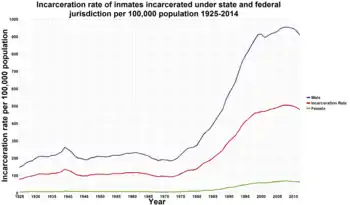< People's Agenda

|
| Subject classification: this is a law learning projects resource. |

A graph of the incarceration rate under state and federal jurisdiction per 100,000 population 1925–2008 (omits local jail inmates). The male incarceration rate (top line) is 15 times the female rate (bottom line).
|
The incarceration rate in the United States today is five times what it was 40 years ago -- roughly half a percent of the population since 2003 vs. 0.1 percent between 1925 and 1974; see the accompanying plot. The Wikipedia article on the United States incarceration rate discusses the changes in law and judicial practices that have driven this increase and offers only one explanation for the socio-political context that drove those changes in law: |
|
Notes
|
This article is issued from Wikiversity. The text is licensed under Creative Commons - Attribution - Sharealike. Additional terms may apply for the media files.